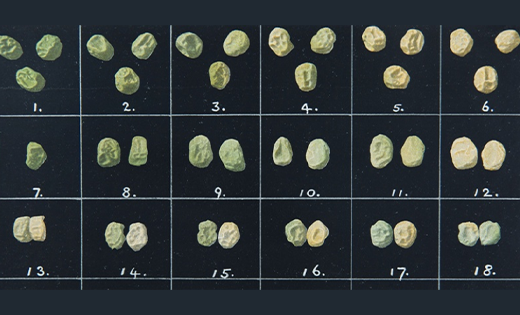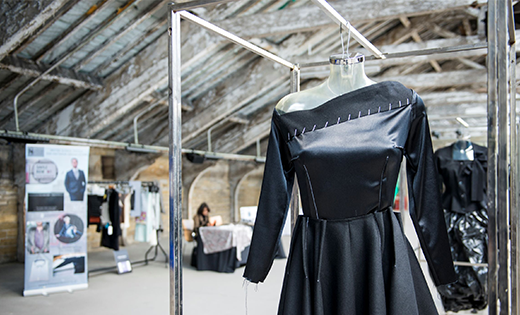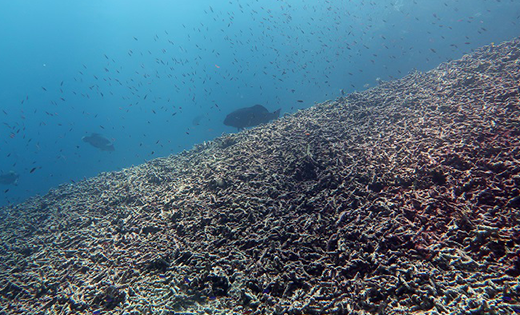Research Round-up – April 2020
Welcome to the latest instalment of our monthly feature series throwing the spotlight on our research success stories.
A new study reveals that proper management of coral reefs can help achieve the multiple goals needed to sustain these ecosystems

The strength of our research is in making a real and telling difference to the world around us, by working across traditional boundaries to find innovative solutions to some of the greatest challenges facing society today.
Here we highlight some of latest projects being pioneered by the expertise and efforts of the highly talented research community at Leeds.
From grant awards to examples of outstanding interdisciplinary work and best practice, we’re keen to showcase your research achievements. See the foot of this article for details of how you can get involved.
Featured in this month's round-up:
- £2.1m funding for SuperSTEM Laboratory
- Developing next generation heart assessments
- Researching the benefit of traditional markets
- Bringing the history of science and genetics teaching together
- Future Fashion Factory funding success
- Saddleworth Moor fire study
- International alliance to accelerate climate action
- Coral reefs struggling in human-dominated world
- Carbon footprint report
- Simple fix creates coronavirus breathing aids
- Low-cost ventilatory support for covid-19 patients
- White Rose Collaboration Fund – applications open
- Research Development Fund – applications open
- Ilkley Literature Festival – express your interest
- Plan S adopts new criteria for Journals to become Open Access
- How to feature in future research round ups
This picture shows an electron microscope based at the SuperSTEM laboratory in Daresbury
£2.1m funding for SuperSTEM Laboratory
Funding for the SuperSTEM Laboratory has been extended through a £2.1m grant from the Engineering and Physical Sciences Research Council (EPSRC).
The SuperSTEM laboratory is the National Research Facility for Advanced Electron Microscopy, based at the Daresbury Science and Innovation Centre. The Centre is part of a wider consortium that also includes the Universities of York, Liverpool, Manchester, Glasgow and Oxford
This funding will support the lab and its mission to offer the scientific community access to unique expertise, and specialised equipment, until at least 2022. The lab houses specialist kit that is essential for a vast range of fields, but cannot always be stored, maintained or operated within a standard university setting. This is usually because it is too expensive and specialised for a university to operate, requires a very demanding and specific environment or needs a critical mass of experts to run it.
SuperSTEM equipment includes microscopes capable of:
- direct imaging of atomic structures
- determining elemental composition; and
- chemical and bonding analysis, down to single-atom precision.
Through these analyses, the laboratory, and thus the funding, will support research into structure-property relationships in advanced materials and devices for the benefit of the scientific community. This has implications for many fields, including:
- condensed matter physics
- catalysis
- biomaterials research
- chemistry
- mineralogy; and
- nuclear materials.
Alongside these capabilities, the funding also supports a new instrument, which is one of only a handful in the world capable of reaching energy resolutions that were not thought possible only a few years ago.
Professor Quentin Ramasse, Director of the SuperSTEM Laboratory, said: "We are delighted to be awarded this funding extension. It is more than just a recognition of our work, it acknowledges the widespread impact of advanced electron microscopy and spectroscopy. EPSRC's clear commitment to this National Research Facility will allow us to serve the community for years to come."
Contact Professor Quentin Ramasse for further information about Leeds’ involvement in SuperSTEM.
Professor of Biomedical Imaging, Jurgen E Schneider, has obtained a Wellcome Trust Investigator in Science Award worth £1.7m to support research in cardiac remodelling.
Cardiac remodelling is characterised by changes to the size and shape of the heart – the more change, the worse the outcome for patients with heart disease is likely to be. The mechanisms underlying remodelling are not known, but changes in the microstructure of the heart muscle are important.
Cardiac Diffusion Magnetic Resonance Imaging (cDMRI) can measure this microstructure, but despite ongoing developments, it is not yet used for clinical management. This is due to technical challenges and to MRI scanner hardware limitations, particularly of the gradient strength.
The Human Connectome Project, designed to provide unparalleled assessment of the brain, developed highly specialised MRI scanners with gradients 4x stronger than those available on standard clinical MRI scanners. This technology has never been exploited outside of the head.
The proposed project combines leading expertise in cDMRI and microstructural imaging with access to one of only three such scanners worldwide (located at the Cardiff University Brain Research Imaging Centre – CUBRIC), to develop next generation assessments of human hearts.
Profesor Schneider said: “My vision is to develop the next generation non-invasive microstructural imaging tools for the heart that will allow for detecting novel biomarkers of cardiac remodelling earlier in the progression of heart disease, and with higher accuracy than ever before.”
The project is led by Professor Schneider, from the Biomedical Imaging Science Department (BISD), Leeds Institute of Cardiovascular and Metabolic Research, and will be supported by experts in cardiology Dr Erica Dall’Armellina and MR physics Dr Irvin Teh (both BISD). It also involves collaborations with Professors Derek Jones (CUBRIC, UK) and Markus Nilsson (University of Lund, Sweden) and their teams, as well as Siemens.
Research into the value of physical markets has received further funding
Researching the benefit of traditional markets
Dr Myfanwy Taylor and members of the Markets4People (M4P) research team are to receive £15,000 in funding from the Economic and Social Research Council (ESRC).
The team is researching new ways to understand the community value traditional markets offer, and the funding is for the project ‘Developing best practice for community markets'. As well as the ESRC funding, an extra £5,000 will be donated by the Charitable Trust, Power to Change.
Markets 4 People has generated an unanticipated wealth of examples of best practice for enhancing community value in markets, which have never previously been collated and fully recognised within national debate. Meanwhile, increasing numbers of market operators have explored regeneration schemes and new management models, and interest, funding and support for community businesses and cooperatives has grown.
Impact Acceleration Accounts funding will allow the team to respond to these developments by co-producing two best practice handbooks:
- a market operators’ guide to best practice in identifying and enhancing community value; and
- a guide for trader/community-run markets.
The project is a collaboration between Leeds, the Open University, National Market Traders Federation and the New Economics Foundation.
A pilot study at Leeds in “what if?” or counterfactual history of science is the basis for a project that has received $1.2 million from the National Science Foundation in the US.
Gregory Radick, Professor of History and Philosophy of Science, is Co-Principal Investigator (PI) with Dr Brian Donovan (PI, Biological Sciences Curriculum Study) and Dr Michelle Smith (PI, Cornell University).
They will collaborate with genetics instructors at colleges and universities across the US to evaluate different ways of helping students understand that the effects of genes depend on other factors, notably genetic background and wider environment.
Traditionally, teaching in genetics starts with the famous pea-crossing experiments of Gregor Mendel. Because Mendel deliberately worked with plants bred to show simple traits unaffected by context, there is a risk that students come away with an exaggerated notion of genes as determinist “super causes.”
In 2013, Professor Radick, Dr Jenny Lewis and Dr Annie Jamieson put on a course for Leeds undergraduates that aimed to give the complexity of 21st Century genetics its due. The inspiration, however, came from Radick’s studies into the early-20th Century debate about Mendel’s work.
Their course updated the arguments of W F R Weldon, an important critic in this debate, who argued the problem with organising knowledge of heredity around Mendelian concepts was precisely their marginalising of context and all the variability it brings.
What difference would it have made had genetics developed as a more 'Weldonian', rather than Mendelian, science?
The Leeds study was a novel attempt to answer this question. It found that students who took a traditional course, starting with Mendel, were on average as determinist about genes at the end as they were at the start, but students taking the Weldonian course were on average less determinist.
Professor Radick said: “The new project represents a wonderful opportunity to take the research beyond the limitations of the original study.
“We’re especially thrilled by the response from genetics teachers, which suggests that, if the new curriculum holds up under further testing, it will fill a real need.”
Success for the fashion industry in a second round investment call
Future Fashion Factory funding success
Future Fashion Factory (FFF) – an integral part of the Creative Industries Clusters Programme, and led by Leeds – has secured more than £693,000 investment in research and development for the industry.
Yorkshire textile mills, independent fashion brands and manufacturers have all been successful in this funding call.
The successful projects will enable businesses to access the expertise of these institutions, as companies collaborate with researchers to tackle major challenges. The projects include:
- building a digital data archive of historic fabric designs (Abraham Moon & Sons, Guiseley)
- developing a predictive model to determine the right-first-time settings for weaving high-value fabrics based on the fabric specification (Bower Roebuck, Holmfirth)
- wireless 3D-zoned heaters that can be printed onto garments (Conductive Transfers, Barnsley)
- finding a second life for automotive leather in the fashion industry (HSSMI, London)
- exploring immersive communication techniques to support growth of independent fashion brands (Nomad Designerwear, Barnsley)
- identifying digital technologies to upscale hand-crafted garment production (Something Wicked, Leeds); and
- detecting weft misalignment in the fabric finishing process with an intelligent sensory system (WT Johnson, Huddersfield).
Professor Stephen Russell, Future Fashion Factory Director and Professor of Textile Materials and Technology, said: “Collaboration is crucial to address the challenges faced by the fashion and textile industry.
“We are proud to deliver projects bringing researchers and companies together, enabling them to share expertise and develop innovative products.
“The UK has a world-class fashion and textile industry, full of highly skilled professionals known for the quality of their products. These projects will help UK businesses to increase their competitive edge in a changing global landscape, creating value and ultimately driving economic growth.”
Future Fashion Factory announced in August 2019 that nine projects had been approved as part of its first funding call, representing an investment of £645,000.
Visit the Future Fashion Factory website for further information.
The impact on public health of the 2018 moor fires has been assessed in a new study
Saddleworth Moor fire study
The wildfires that broke out on Saddleworth Moor and Winter Hill in June 2018 burned for about three weeks.
A hundred firefighters and the army attended, and smoke from the fires spread widely across the north-west of England.
In a new study, published in Environmental Research Letters, research led by Leeds used computer simulations to calculate the effect of the fires on air quality and the resulting impact on health.
Their findings include:
- the fires caused poor air quality over a large region (including Bolton, Wigan and Southport)
- five million people were exposed to dangerous particles that were PM2.5 above the recommended level set by the World Health Organisation on at least one day, between 23 and 30 June
- the PM5 pollution from the fires increased the number of deaths brought forward by up to 165% (Saddleworth Moor) and 95% (Winter Hill), compared to if there were no fires; and
- the authors estimate the economic impact of the fires to be £21.1 million.
The authors said: "It's clear from this study that the pollution from wildfires can have a significant effect on public health. The smoke contains very high levels of toxic particulate matter aerosol, which can be transported long distances. When this smoke passes over urban areas, it adds to an already polluted environment and can cause very poor air quality.
"We should be aware that the smoke from wildfires can travel long distances and can damage people's health, even far from the fires."
The study used a computer model of the atmosphere to investigate the impacts of air pollution from the fires on the population in the north-west of England. In the model, two scenarios were considered: 1) a scenario with no wildfires and 2) a scenario in which pollutants from the fires are included.
The scenarios allowed researchers to investigate the difference in pollution that occurred as a result of the fires. From this, they calculated the effect of the fire on air quality and then attributed how many deaths were brought forward due to PM2.5 pollution from the fires directly.
Leeds is involved in a new alliance of 40 of the world's leading climate research universities
International alliance to accelerate climate action
We are a founding member of the International Universities Climate Alliance, which launched Thursday 2 April.
Initiated by the University of New South Wales, Sydney, the Climate Alliance involves 40 of the world’s leading climate research universities, from countries including Brazil, China, Fiji, Ghana, Kenya, Netherlands, Singapore, the UK and USA.
Alliance members will work together to identify the most effective ways to communicate research-based facts related to climate change to the public.
Members will engage in work across climate change science, impact, mitigation strategies and adaptation, with Leeds planning to take a leading role sharing knowledge for net-zero and climate-resilient solutions across the network.
Vice-Chancellor, Sir Alan Langlands, said: “Tackling the climate crisis requires global cooperation on an unprecedented scale.
“The alliance can deliver this by sharing best practice across universities, providing a coordinated evidence base to inform urgent decisions, and training a new generation of innovative researchers to deliver net-zero on our campuses and around the world.”
Professor Piers Forster, Director of the Priestley International Centre for Climate, said: “This Alliance has world-leading research capabilities – we now need to work much closer with our governments, our cities, our industries and to learn by doing.
“Through this new international collaboration, we hope to provide a leading, unified voice that can help drive the acceleration in changes required.”
Dr Louise Ellis, Director of Sustainability at Leeds, said: “Here at Leeds, we are committed to tackling the climate crisis head on; through changes we are making to our campus operations, our research expertise, the way we interact with the world and through our curriculum across the board.
“We’re proud to be joining this Alliance to help increase the impact that our own climate action can achieve on a global scale.”
See the International Universities Climate Alliance website for further information.
New findings reveal that proper management of coral reefs can help achieve the multiple goals needed to sustain these ecosystems
Coral reefs struggling in human-dominated world
A new study reveals proper management of coral reefs can help achieve the multiple goals needed to sustain these ecosystems, but management effectiveness is dependent on the reef’s location.
An international team of researchers, including Dr Maria Beger from Biological Sciences, assessed roughly 1,800 tropical reefs from 41 countries across the globe to understand whether no-fishing marine reserves and other fisheries restrictions are helping to achieve multiple management goals.
The study, led by Professor Josh Cinner from the ARC Centre of Excellence for Coral Reef Studies at James Cook University, found that only 5% of the reefs surveyed were simultaneously able to meet the combined goals of providing enough fishing stocks, maintaining biodiversity and a working ecosystem.
Coral reefs are facing intense degradation due to overfishing, pollution and climate change. In addition to being the only home for a large number of marine species, the livelihoods of many people and communities depend on these ecosystems.
Effective conservation of these diverse ecosystems requires aiming for multiple goals that apply to multiple species.
By examining the fish communities in the reefs, the team was able to assess whether the reefs' protections were achieving biodiversity, fisheries and ecosystem function goals.
Their findings, published in Science, show there is evidence that no-fishing marine reserves and other fisheries restrictions can help reefs meet conservation goals, but only if the management efforts are in the right locations.
Dr Beger said: “Even limited benefits that come from no-fishing marine reserves and other fisheries restrictions are worth it. While they may not be fully achieving the desired multiple goals, they will slow and potentially halt the decline of reef ecosystems.
“None of the conservation goals can be achieved without immediate, substantial and broad-scale investments into management of coral reefs though, and wide-spread reduction of use of reef resources.
Nearly half the UK’s carbon footprint comes from emissions released overseas to satisfy UK-based consumption, according to a new report.
Products including clothing, processed foods and electronics imported into the UK are counted as the manufacturing country’s emissions, not the UK’s – although they would not have been produced were it not for UK demand.
These emissions account for 46% of the UK’s carbon footprint, yet are not currently covered by national reporting or included in the UK’s net-zero target.
The report, Carbon Footprint: Exploring the UK’s contribution to climate change, was commissioned by the Worldwide Fund for Nature (WWF) and highlights the importance of addressing carbon intensive imports such as animal feed and fossil fuels, which fuel our cars and heat our homes, and using the UK’s new trade policy to encourage the highest standards of environmental production abroad.
Professor John Barrett from the Sustainability Research Institute, and also one of the report’s authors, said: "Over the past 30 years, the UK’s emissions associated with our consumption have only declined by 15% at a time when they need to reduce to close to zero in the next 30 years.
"Increasingly, the impact of our consumption occurs outside the UK, creating a situation where our emissions inside the country reduce while emissions associated with imports increase.
"It is essential the UK commits to reducing its emissions both inside and outside the UK to adequately respond to the climate crisis."
Engineers and scientists have developed a way to convert a sleep apnoea machine into a ventilator to treat people with covid-19.
The modification – of a device known as a NIPPY 3+, which is being phased out of service – came about following a collaboration between clinical staff, engineers and physicists at Leeds Teaching Hospitals Trust (LTHT) and academics and technologists at the University.
It has been estimated that there are thousands of similar devices across the NHS, and their rapid modification has the potential to significantly increase the respiratory support available to very ill patients across the country. There are about 100 of the devices in Leeds hospitals.
Sleep apnoea is a condition where people stop breathing in their sleep – the machine ensures their air supply is maintained.
The modification required so the device can be used to treat covid-19 patients is straightforward and involves changes to the device’s settings and reconfiguring the supply of oxygen, so it flows directly to the face mask worn by the patient.
The machine operates in a mode called CPAP: constant positive airway pressure. That means the pressure inside the mask is slightly raised, keeping the patient’s airway open and making it easier for them to breathe. It provides enriched oxygen of between 40 to 60%.
Because it is a modification to a device, it does not have to go through a full regulatory approval process.
Professor Nikil Kapur, from the School of Mechanical Engineering, said: "The collaboration showed how the University was able to support colleagues at LTHT, who had brilliant ideas but insufficient time to investigate them because they were having to prepare their hospitals to deal with the unfolding pandemic.”
A research team at Leeds has developed a way of creating a ventilatory system for covid-19 patients that can be made rapidly on a 3D printer.
It is a low-tech solution based on redesigning an existing medical device known as a Venturi valve. It does not need electricity and has no moving parts and could be made in countries without access to advanced manufacturing facilities.
Known as the Leeds Venturi valve, the remodelled device is subject to regulatory approval.
This is the second time in a month that the research team has found a way of repurposing existing medical technology to increase the number of breathing aids available for patients.
In this latest development, the researchers from Leeds, Leeds Teaching Hospitals NHS Trust (LTHT) and Bradford Teaching Hospitals NHS Foundation Trust focused on the Venturi valve – a small plastic device normally used to increase the flow of oxygen to a patient.
One end of the valve is attached to the oxygen-supply pipe by a patient’s bed or to an oxygen cylinder. The other end connects to the tubing that goes to the person’s oxygen mask.
The repurposed device not only delivers an increased flow of oxygen to the patient, it also raises the pressure of that flow, opening the tiny air sacs in the lungs that are damaged by the virus and allowing oxygen to get into the body.
Importantly, the device produces an effect similar to a continuous positive airway pressure, or CPAP, machine – a form of intermediate-level ventilator capable of delivering oxygen at the right concentration and pressure to have a therapeutic effect.
Dr Pete Culmer, Associate Professor in the School of Mechanical Engineering at Leeds, said: “Our work has focused on investigating more rapid ways of getting life-saving technology to the side of patients as the pandemic spreads.
“Across the world, there have been concerns about increasing the number of ventilators that are available. We have now looked at two solutions. Both involve adapting existing technologies and that dramatically reduces the time it takes to get equipment to the patient’s bedside.
“Taking established technology and repurposing it means there is a greater chance that we can make real our solutions in a timely and effective way.”
White Rose Collaboration Fund – applications open
The White Rose Collaboration Fund – operated by the White Rose University Consortium (WRUC) – is now open for applications.
The fund supports and encourages emerging partnerships across the Universities of Leeds, Sheffield and York, in particular to support projects that have the potential to lead to larger, more strategic initiatives.
The maximum award has been increased by a third to £15,000, allowing projects a larger expenditure and scope, often resulting in larger funding down the line.
Recent examples of White Rose Collaboration Fund success include Dr Gemma Traviss-Turner's project looking at weight management for adults with severe mental illness.
Dr Traviss-Turner said: "White Rose Funding enabled us to extend an existing collaboration to work up a £2.7m Programme Grant addressing the important issue of supporting physical activity through co-production in people with severe mental illness."
Applications are open until Tuesday 30 June via the applications page.
Research Development Fund – applications open
The Research Development Fund (RDF) is now open for application until Friday 5 June 2020.
The fund (a maximum of £500 per application) can be used to support involvement of members of the public (e.g. public, patients, carers, service users and other stakeholders) in shaping or developing research ideas.
Two distinct types of projects are considered:
- holding an event/meeting (or series of smaller meetings) to inform a particular research grant application; or
- establishing an ongoing PPIE panel/user group in a specific research area, where the need for such a group has been identified and no other group exists already; it is advantageous to outline how the ongoing support for such a group will be met.
Previous recipients of the award have said: "The lessons learned were only positive: my research proposal is immeasurably richer thanks to the opportunities afforded by this small grant. My research will have a sharper focus on the needs, demands and interests of the communities with whom I am working as a result."
Visit the RDF page or contact the Public Engagement team for further information.
Ilkley Literature Festival – express your interest
Ilkley Literature Festival (ILF) – the longest-standing literature festival in the north of England – takes place between Friday 2 and Sunday 18 October (subject to public health advice, in light of the coronavirus pandemic).
If you have recently published work – a book or journal article – that would translate well into an accessible presentation for a general audience, the Festival organisers would like to hear from you.
Their events cover a broad range of interest areas, including literature and language, creative writing, history, economics, politics and current affairs, science and technology, sociology, art history, climate change and environmental issues, to name just a few.
Through a partnership with the University brokered by the Cultural Institute, ILF is committed to providing staff with opportunities for public engagement.
Each year, about 200 events take place in a variety of venues across the town and beyond, attracting total audiences of 24,000 people. Through the Cultural Institute’s partnership, Leeds is an official supporter of the Festival, with writers and researchers from the University regularly featuring in the programme of talks, events and activities.
By presenting at ILF, you will have opportunity to:
- introduce engaged and curious public audiences to your work
- build your professional profile, and that of your research
- promote published works
- network with other writers and publishing professionals; and
- connect with an Arts Council England National Portfolio arts organisation, and explore the potential for further partnerships.
You can express your interest in hosting an ILF event until 5pm on Wednesday 20 May 2020.
 Plan S adopts new criteria for Journals to become Open Access
Plan S adopts new criteria for Journals to become Open Access
Plan S – the initiative to make funded research available immediately through Open Access publishing – has updated its criteria for journals.
Launched in 2018 by cOAlition S, an international consortium of research funders including UKRI and Wellcome, Plan S requires that, from 2021, research funded by Plan S funders must be published in compliant Open Access journals or platforms or made immediately available through compliant repositories without an embargo.
Open Access refers to free, unrestricted online access to research outputs, such as journal articles, research data, preprints and books. Content is open to all, with no paywalls.
From January 2021 Plan S will fund Open Access publishing in hybrid/subscription journals, so long as they fall under a ‘transformative agreement’ or transformative journal. Each route commits the journal to transition to Open Access over a period of time.
Nature is one of the latest major publishers to sign up to Plan S under the new ‘transformative journal’ route.
Dr Stella Butler, University Librarian and Keeper of the Brotherton Collection, said: “Amid the global Covid-19 crisis, there has never been more of an argument for unfettered open access to research. As many institutions face potential cuts, it is vital publishers are held accountable for the fees they charge for their services.
Kirstine McDermid, Library Research Support Advisor and lead on Plan S added: “It is hoped that the updated journal criteria will make it easier for many more publishers to sign up to Plan S, making a larger proportion of research open access and creating more compliant publishing venues for UKRI and Wellcome funded researchers”.
You can find out more about Plan S by visiting the Library website, with further details about changes to the initiative available on the Library blog.
If you are a journal editor wishing to become Plan S compliant, you can visit the cOAlition website to apply for ‘transformative journal’ status.
How to feature in future research round ups
Please contact Internal Communications if you or one of your colleagues would like to appear in this monthly feature.
Posted in: University news







